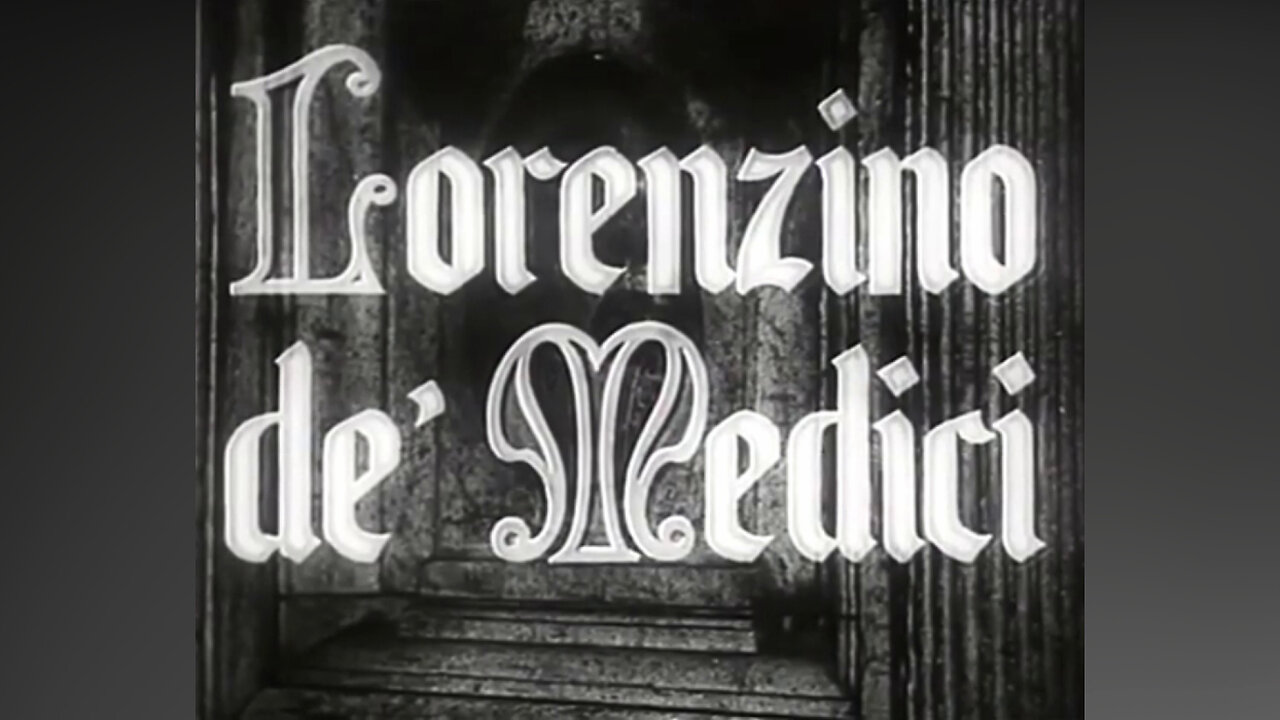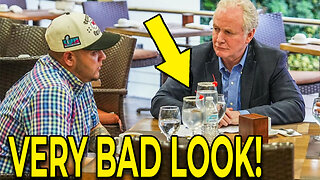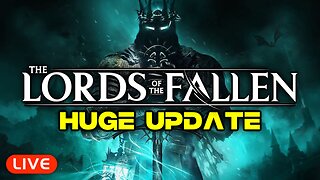Premium Only Content

Lorenzino de' Medici (Film 1935 - ENG SUB)
Lorenzino de' Medici is a 1935 film directed by Guido Brignone. Audio in Italian with English subtitles.
The film is inspired by the events that actually happened in Florence in the first half of the sixteenth century, and already described in the play Lorenzaccio by Alfred de Musset. The film is a romanticised version of the story.
The protagonist Alexander Moissi (who was credited in the titles Italianized as Alessandro Moissi) was an Austrian film actor of Albanian origin, very famous in those years throughout Europe; this was the only film he shot in Italy.
Lorenzino de' Medici (22 March 1514 – 26 February 1548), also known as Lorenzaccio, was an Italian politician, writer, and dramatist, and a member of the Medici family. He was the son of Pierfrancesco II de' Medici or Pierfrancesco il Giovane ("the Younger") and Maria Soderini.
Lorenzino established a close relationship with his cousin Alessandro, who had become lord of Florence in 1530 and duke in 1532. The two were partners in riotous escapades, but the authenticity of their friendship is doubtful and their relationship had more than one dark side. In 1536, the duke sided against Lorenzino in a legal controversy on the inheritance of Pierfrancesco the Elder, Lorenzino's great-grandfather, which caused substantial financial damage to Lorenzino. In the same year, Alessandro married Margaret of Parma, the natural daughter of the Emperor Charles V.
On the evening of 6 January 1537, Lorenzino lured Alessandro to his apartments with the promise of a night of passion, and left him alone pretending that he was going to fetch a woman who had already agreed to meet him. According to most historians, the woman was Caterina Soderini, wife of Leonardo Ginori, but others think it was Laudomia, Lorenzino's sister. In the meantime, Alessandro fell asleep and, having previously sent away his men, he was completely defenseless when Lorenzino came back with his servant Piero di Giovannabate, also known as Scoronconcolo. The two men assaulted the duke with swords and daggers, and Alessandro was killed even though he reacted ferociously and fought with all his might.
Many hypotheses have been proposed to explain the reasons for the murder, from the personal resentment caused by jealousy or patrimonial reasons, to Lorenzino's desire to make a sensational gesture to immortalize his glory. Lorenzino himself, however, stated in his famous Apology - written only a few days after his crime - that he acted for political reasons; he killed the duke to free Florence from the man that many considered to be a tyrant.
The Florentine republican exiles generally had the same explanation; they considered Lorenzino a hero, since in so doing he could have made the reintroduction of the Republic possible. Dominant figures in the republican exiles, such as Benedetto Varchi, even compared Lorenzino's cause and actions to Brutus, the killer of Julius Caesar who held the same republicanism ideal. After the murder, Lorenzino took the horses he had previously prepared and left Florence along with Piero and another servant. Lorenzino reached Venice, where he was welcomed with open arms by the very rich banker Filippo Strozzi, the leader of the exiles, who promised him that he would marry his sons Piero and Roberto to Lorenzino's sisters Laudomia and Maddalena de' Medici. Among the many other exiles that exulted over the duke's death were the famous men of letters Iacopo Nardi and Benedetto Varchi: the latter said that Lorenzino was greater than Brutus. Also the poet Luigi Alamanni praised Lorenzino from France, whereas the sculptor Jacopo Sansovino promised to dedicate a statue to him.
With Alessandro's death, the main branch of the Medici family was extinguished. The lack of a suitable lineal descendant created the conditions for the rise to power of the seventeen-year-old Cosimo, a member of the cadet branch of the family who was chosen as the new duke with the approval of the Holy Roman Emperor Charles V.
After a few days in Venice, Lorenzino decided to go to Mirandola, where he was hosted by Count Galeotto Pico and remained for around two weeks. He then returned to Venice and from there, on 16 February 1537, he left to go to Constantinople, with the Ottoman ambassador in Venice and Giorgio Gritti, son of Doge Andrea. The choice to leave Italy was due partly to the risk of being killed and partly to a diplomatic mission to the Ottoman Sultan Suleiman the Magnificent on behalf of the King of France.
The battle of Montemurlo, won by Cosimo's army, ended the hopes of Filippo Strozzi and the other exiles. Lorenzino's patron Filippo was taken prisoner. He died in 1538 (suicide, according to the official version) after being tortured in the attempt to establish an unlikely connection between him and the Duke's assassination. In September 1537 Lorenzino went to France, to the court of Francis I of France, where he could count on the political support of the king and on the hospitality of many Florentines, especially his maternal uncle, the bishop of Saintes Giuliano Soderini, and the royal treasurer Giuliano Bonaccorsi.
In 1544 Lorenzino returned for good to Venice, where he was in close contact with the other Florentine exiles and established a friendship with the papal legate Giovanni Della Casa. In Venice, a nest of imperial and Medici spies, Lorenzino was much more vulnerable than in France, and the attempts to kill him and revenge the death of Duke Alessandro multiplied. The situation got even more complicated when, between the end of 1547 and the beginning of 1548, almost all the Florentines left Venice and moved to France, thus leaving Lorenzino isolated. Consequently, on 26 February 1548, Lorenzino was murdered in Venice by two hired killers. One of them, Francesco da Bibbona, left a detailed account of the deed which includes precious information on the execution of the murder.
For several centuries, it has been believed that the Medici secretary Giovanni Francesco Lottini had organized the murder, but new research has demonstrated that he played no part in it. Moreover, both his contemporaries and historians of the following centuries have always believed that Lorenzino's assassination had been ordered by Duke Cosimo I, as revenge for the murder of his predecessor. On the contrary, a study by Stefano Dall’Aglio has shown that the entire operation was orchestrated by the Emperor Charles V, who could not forgive the death of his son-in-law, the husband of his daughter Margaret. It was Charles V who explicitly ordered the murder, writing from Augsburg unbeknownst to Cosimo, and gave detailed instructions to his ambassador in Venice, Juan Hurtado de Mendoza, who was in charge of the operation.
Lorenzino was also a writer. In his Apology he defended himself, explaining that he had committed the murder for the love of liberty: he had followed the example of Brutus – one of the assassins of Julius Caesar – and had murdered the duke after pretending he was his faithful servant and friend.
The Apology is considered one of the loftiest examples of Renaissance eloquence and a masterpiece of anti-tyrannical thought. It was written in two subsequent versions, the first of which, not very different from the definitive one, dates back to January 1537, a few days after the murder. He also authored a play entitled Aridosia, written around 1535 and successfully presented in Florence, first at the Spedale dei Tessitori and later at Palazzo Medici.
-
 1:13:25
1:13:25
Adaneth - Cinema&TV
4 days agoYotsuya Kwaidan/Ghost of Yotsuya - Part 2 (Film 1949 - ENG SUB)
35 -
 LIVE
LIVE
Stephen Gardner
24 minutes ago🔴TRUMP CURSE: Letitia James PANICS as ALL Documents made public!
4,821 watching -
 UPCOMING
UPCOMING
Nerdrotic
36 minutes agoFantastic 4 HER! Daredevil BORE Again SUCKS! Disney Star Wars is DESPERATE | FNT Vegas 350
-
 LIVE
LIVE
Barry Cunningham
4 hours agoPRESIDENT TRUMP AND EL SALVADOR PRESIDENT NAYIB BUKELE PUT THE DEMOCRATS IN CHECKMATE!
12,963 watching -
 13:48
13:48
T-SPLY
2 hours agoEL SALVADOR TRIP FLOPS: Senator Slammed Hard!
4.99K16 -
 LIVE
LIVE
MrR4ger
20 hours agoBRAND NEW RPG - MANDRAGORA *ENTER FAELDUUM*
574 watching -
 LIVE
LIVE
Crypto Power Hour
3 hours ago $0.77 earnedFrom Wall Street Algorithms to Blockchain Disruption
191 watching -
 LIVE
LIVE
SilverFox
15 hours ago🔴LIVE - HUGE UPDATE! LORDS OF THE FALLEN 2.0
429 watching -
 4:38:41
4:38:41
Viss
5 hours ago🔴LIVE - Taking Wins all Over The PUBG Battleground!
34.3K2 -
 1:44:58
1:44:58
The Quartering
4 hours agoKarmelo Anthony Supporters SWAT Victims Dad, Hatchet Victim Dies, FSU School Shooter Update & More
112K77